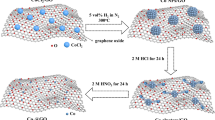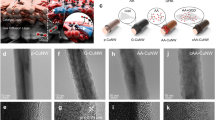Abstract
Despite the growing demand for hydrogen peroxide it is almost exclusively manufactured by the energy-intensive anthraquinone process. Alternatively, H2O2 can be produced electrochemically via the two-electron oxygen reduction reaction, although the performance of the state-of-the-art electrocatalysts is insufficient to meet the demands for industrialization. Interestingly, guided by first-principles calculations, we found that the catalytic properties of the Co–N4 moiety can be tailored by fine-tuning its surrounding atomic configuration to resemble the structure-dependent catalytic properties of metalloenzymes. Using this principle, we designed and synthesized a single-atom electrocatalyst that comprises an optimized Co–N4 moiety incorporated in nitrogen-doped graphene for H2O2 production and exhibits a kinetic current density of 2.8 mA cm−2 (at 0.65 V versus the reversible hydrogen electrode) and a mass activity of 155 A g−1 (at 0.65 V versus the reversible hydrogen electrode) with negligible activity loss over 110 hours.
This is a preview of subscription content, access via your institution
Access options
Access Nature and 54 other Nature Portfolio journals
Get Nature+, our best-value online-access subscription
$29.99 / 30 days
cancel any time
Subscribe to this journal
Receive 12 print issues and online access
$259.00 per year
only $21.58 per issue
Buy this article
- Purchase on Springer Link
- Instant access to full article PDF
Prices may be subject to local taxes which are calculated during checkout




Similar content being viewed by others
Data availability
All data is available in the main text or in the Supplementary Information.
References
Yang, S. et al. Toward the decentralized electrochemical production of H2O2: a focus on the catalysis. ACS Catal. 8, 4064–4081 (2018).
Pulidindi, K. & Pandey, H. Hydrogen Peroxide Market Size by End-User (Paper & Pulp, Chemical, Waste Water Treatment, Mining) Report GMI851 (Global Market Insights, 2016).
Riedl, H.-J. & Pfleiderer, G. Production of hydrogen peroxide. US patent 2,158,525 (1939).
Campos-Martin, J. M., Blanco-Brieva, G. & Fierro, J. L. G. Hydrogen peroxide synthesis: an outlook beyond the anthraquinone process. Angew. Chem. Int. Ed. 45, 6962–6984 (2006).
Siahrostami, S. et al. Enabling direct H2O2 production through rational electrocatalyst design. Nat. Mater. 12, 1137–1143 (2013).
Verdaguer-Casadevall, A. et al. Trends in the electrochemical synthesis of H2O2: enhancing activity and selectivity by electrocatalytic site engineering. Nano Lett. 14, 1603–1608 (2014).
Jirkovský, J. S. et al. Single atom hot-spots at Au–Pd nanoalloys for electrocatalytic H2O2 production. J. Am. Chem. Soc. 133, 19432–19441 (2011).
Sheng, Y. et al. Superoxide dismutases and superoxide reductases. Chem. Rev. 114, 3854–3918 (2014).
McCord, J. M. & Fridovich, I. Superoxide dismutase. J. Biol. Chem. 244, 6049–6055 (1969).
Chen, R., Li, H., Chu, D. & Wang, G. Unraveling oxygen reduction reaction mechanisms on carbon-supported Fe-phthalocyanine and Co-phthalocyanine catalysts in alkaline solutions. J. Phys. Chem. C 113, 20689–20697 (2009).
Yamanaka, I., Tazawa, S., Murayama, T., Iwasaki, T. & Takenaka, S. Catalytic synthesis of neutral hydrogen peroxide at a CoN2Cx cathode of a polymer electrolyte membrane fuel cell (PEMFC). ChemSusChem 3, 59–62 (2010).
Wang, A., Li, J. & Zhang, T. Heterogeneous single-atom catalysis. Nat. Rev. Chem. 2, 65–81 (2018).
Liu, P. et al. Photochemical route for synthesizing atomically dispersed palladium catalysts. Science 352, 797–800 (2016).
Duchesne, P. N. et al. Golden single-atomic-site platinum electrocatalysts. Nat. Mater. 17, 1033–1039 (2018).
Guan, J. et al. Water oxidation on a mononuclear manganese heterogeneous catalyst. Nat. Catal. 1, 870–877 (2018).
Lee, B.-H. et al. Reversible and cooperative photoactivation of single-atom Cu/TiO2 photocatalysts. Nat. Mater. 18, 620–626 (2019).
Chung, H. T. et al. Direct atomic-level insight into the active sites of a high-performance PGM-free ORR catalyst. Science 357, 479–484 (2017).
Yang, H. B. et al. Atomically dispersed Ni(ı) as the active site for electrochemical CO2 reduction. Nat. Energy 3, 140–147 (2018).
Zitolo, A. et al. Identification of catalytic sites for oxygen reduction in iron- and nitrogen-doped graphene materials. Nat. Mater. 14, 937–942 (2015).
Fei, H. et al. General synthesis and definitive structural identification of MN4C4 single-atom catalysts with tunable electrocatalytic activities. Nat. Catal. 1, 63–72 (2018).
Pan, Y. et al. A bimetallic Zn/Fe polyphthalocyanine-derived single-atom Fe–N4 catalytic site: a superior trifunctional catalyst for overall water splitting and Zn–air batteries. Angew. Chem. Int. Ed. 57, 8614–8618 (2018).
Li, J. et al. Atomically dispersed manganese catalysts for oxygen reduction in proton-exchange membrane fuel cells. Nat. Catal. 1, 935–945 (2018).
Choi, C. H. et al. The Achilles’ heel of iron-based catalysts during oxygen reduction in an acidic medium. Energy Environ. Sci. 11, 3176–3182 (2018).
He, Y. et al. Highly active atomically dispersed CoN4 fuel cell cathode catalysts derived from surfactant-assisted MOFs: carbon-shell confinement strategy. Energy Environ. Sci. 12, 250–260 (2019).
Abild-Pedersen, F. et al. Scaling properties of adsorption energies for hydrogen-containing molecules on transition-metal surfaces. Phys. Rev. Lett. 99, 016105 (2007).
Bagri, A. et al. Structural evolution during the reduction of chemically derived graphene oxide. Nat. Chem. 2, 581–587 (2010).
Li, X. et al. Simultaneous nitrogen doping and reduction of graphene oxide. J. Am. Chem. Soc. 131, 15939–15944 (2009).
Chen, D., Feng, H. & Li, J. Graphene oxide: preparation, functionalization, and electrochemical applications. Chem. Rev. 112, 6027–6053 (2012).
Lin, L.-C. & Grossman, J. C. Atomistic understandings of reduced graphene oxide as an ultrathin-film nanoporous membrane for separations. Nat. Commun. 6, 8335 (2015).
Andreiadis, E. S. et al. Molecular engineering of a cobalt-based electrocatalytic nanomaterial for H2 evolution under fully aqueous conditions. Nat. Chem. 5, 48–53 (2013).
Ramaswamy, N. & Mukerjee, S. Influence of inner- and outer-sphere electron transfer mechanisms during electrocatalysis of oxygen reduction in alkaline media. J. Phys. Chem. C 115, 18015–18026 (2011).
Lu, Z. et al. High-efficiency oxygen reduction to hydrogen peroxide catalysed by oxidized carbon materials. Nat. Catal. 1, 156–162 (2018).
Kim, H. W. et al. Efficient hydrogen peroxide generation using reduced graphene oxide-based oxygen reduction electrocatalysts. Nat. Catal. 1, 282–290 (2018).
Zheng, Z., Ng, Y. H., Wang, D.-W. & Amal, R. Epitaxial growth of Au–Pt–Ni nanorods for direct high selectivity H2O2 production. Adv. Mater. 28, 9949–9955 (2016).
Yang, S., Kim, J., Tak, Y. J., Soon, A. & Lee, H. Single-atom catalyst of platinum supported on titanium nitride for selective electrochemical reactions. Angew. Chem. Int. End. 55, 2058–2062 (2016).
Verdaguer-Casadevall, A., Hernandez-Fernandez, P., Stephens, I. E. L., Chorkendorff, I. & Dahl, S. The effect of ammonia upon the electrocatalysis of hydrogen oxidation and oxygen reduction on polycrystalline platinum. J. Power Sources 220, 205–210 (2012).
Jirkovský, J. S., Halasa, M. & Shiffrin, D. J. Kinetics of electrocatalytic reduction of oxygen and hydrogen peroxide on dispersed gold nanoparticles. Phys. Chem. Chem. Phys. 12, 8042–8052 (2010).
Sa, Y. J., Kim, J. H. & Joo, S. H. Active edge-site-rich carbon nanocatalysts with enhanced electron transfer for efficient electrochemical hydrogen peroxide production. Angew. Chem. Int. Ed. 58, 1100–1105 (2019).
Chen, S. et al. Designing boron nitride islands in carbon materials for efficient electrochemical synthesis of hydrogen peroxide. J. Am. Chem. Soc. 140, 7851–7859 (2018).
Edwards, J. K. et al. Switching off hydrogen peroxide hydrogenation in the direct synthesis process. Science 323, 1037–1041 (2009).
Wang, X. X., Prabhakaran, V., He, Y., Shao, Y. & Wu, G. Iron-free cathode catalysts for proton-exchange-membrane fuel cells: cobalt catalysts and the peroxide mitigation approach. Adv. Mater. 31, 1805126 (2019).
Shahriary, L. & Athawale, A. A. Graphene oxide synthesized by using modified Hummers approach. Int. J. Renew. Energy Environ. Eng. 2, 58–63 (2014).
Kresse, G. & Furthmüller, J. Efficient iterative schemes for ab initio total-energy calculations using a plane-wave basis set. Phys. Rev. B 54, 11169–11186 (1996).
Blöchl, P. E. Projector augmented-wave method. Phys. Rev. B 50, 17953–17979 (1994).
Hammer, B., Hansen, L. B. & Nørskov, J. K. Improved adsorption energetics within density-functional theory using revised Perdew–Burke–Ernzerhof functionals. Phys. Rev. B 59, 7413–7421 (1999).
Monkhorst, H. J. & Pack, J. D. Special points for Brillouin-zone integrations. Phys. Rev. B 13, 5188–5192 (1976).
Man, I. C. et al. Universality in oxygen evolution electrocatalysis on oxide surfaces. ChemCatChem 3, 1159–1165 (2011).
Nørskov, J. K. et al. Origin of the overpotential for oxygen reduction at a fuel-cell cathode. J. Phys. Chem. B 108, 17886–17892 (2004).
Calle-Vallejo, F., Martínez, J. I. & Rossmeisl, J. Density functional studies of functionalized graphitic materials with late transition metals for oxygen reduction reactions. Phys. Chem. Chem. Phys. 13, 15639–15643 (2011).
Acknowledgements
Synthesis and physicochemical property analysis of the catalysts were supported by the Research Center Program of the IBS (IBS-R006-D1) in Korea (T.H.). Electrochemical analysis was supported by Research Center Program of the IBS (IBS-R006-A2, Y.-E.S.). X-ray absorption spectra characterization at the Pohang Accelerator Laboratory (PAL) 8C beamline was supported by a National Research Foundation of Korea (NRF) grant funded by the Korea government (no. 2018M1A2A2061998). Theoretical analysis was supported by the 2019 Research Fund of the University of Seoul (J.S.Y.).
Author information
Authors and Affiliations
Contributions
E.J., H.S., B.-H.L., J.S.Y., Y.-E.S. and T.H. conceived the research. E.J., H.S. and B.-H.L. designed the experiments. E.J., B.-H.L., H.S.L., J.K. and W.H.A. performed and analysed the results. H.S. and S.P. performed electrochemical measurements. V.E., S.L. and J.S.Y. performed the computational analysis. S.-P.C. conducted the high-angle annular dark-field scanning transmission electron microscopy analysis. K.-S.L. contributed to the X-ray absorption experiments and analysis. E.J., H.S., B.-H.L., J.S.Y., Y.-E.S. and T.H. wrote the manuscript. J.S.Y., Y.-E.S. and T.H. supervised the project. All the authors commented on the manuscript.
Corresponding authors
Ethics declarations
Competing interests
The authors declare no competing interests.
Additional information
Publisher’s note Springer Nature remains neutral with regard to jurisdictional claims in published maps and institutional affiliations.
Supplementary information
Supplementary Information
Supplementary Notes, Figs. 1–41, Tables 1–4 and references 1–18.
Rights and permissions
About this article
Cite this article
Jung, E., Shin, H., Lee, BH. et al. Atomic-level tuning of Co–N–C catalyst for high-performance electrochemical H2O2 production. Nat. Mater. 19, 436–442 (2020). https://doi.org/10.1038/s41563-019-0571-5
Received:
Accepted:
Published:
Issue Date:
DOI: https://doi.org/10.1038/s41563-019-0571-5
This article is cited by
-
Constructing sulfur and oxygen super-coordinated main-group electrocatalysts for selective and cumulative H2O2 production
Nature Communications (2024)
-
Photochemical tuning of dynamic defects for high-performance atomically dispersed catalysts
Nature Materials (2024)
-
Porous heterostructure of h-BN/carbon as an efficient electrocatalyst for hydrogen peroxide generation
Carbon Letters (2024)
-
Regulating oxygenated groups and carbon defects of carbon-based catalysts for electrochemical oxygen reduction to H2O2 by a mild and self-recycled modification strategy
Carbon Research (2024)
-
Mechanochemical route to fabricate an efficient nitrate reduction electrocatalyst
Nano Research (2024)



